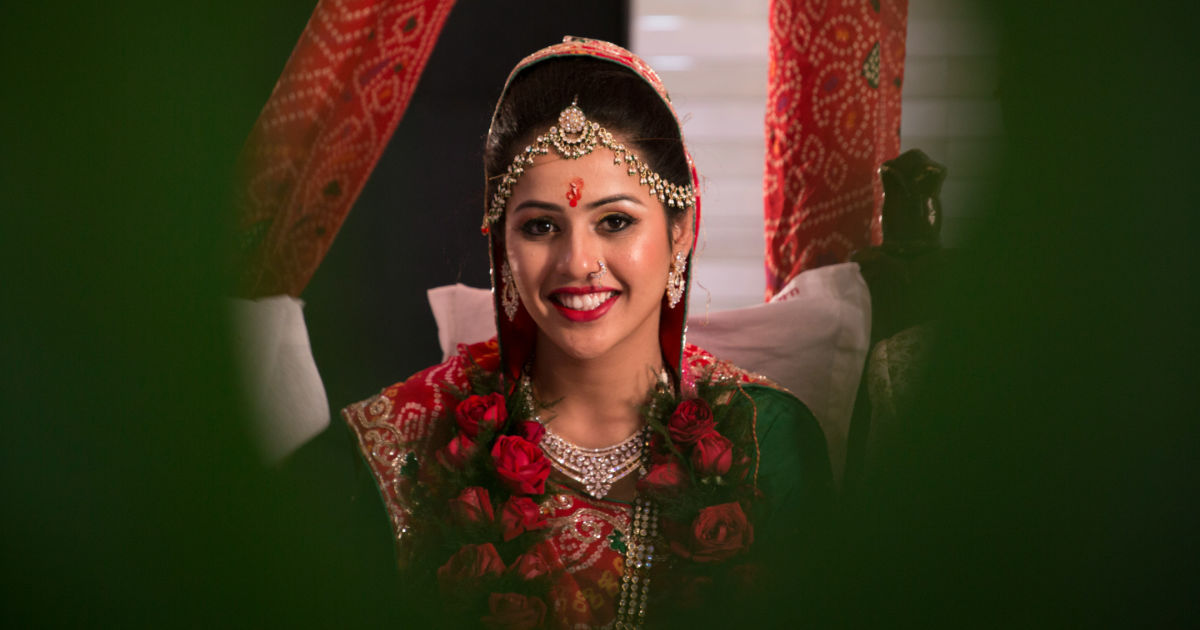A Hindu bride was decorated with sixteen adornments on her wedding day. These adornments are called Solah (sixteen) Shringar. This ritual has been practiced since Vedic times. The story behind Solah Shringar is that Rati, who before she became the wife of God Kamadev (God of Love) was very plain. She prayed to Lakshmi and performed a severe penance. Lakshmi blessed her with sixteen adornments and Kamadev fell in love with her and married her.
Each of the sixteen adornments holds a special significance for the bride and the wedding.
Sindoor is the first adornment, it is also known as Kumkum. It is vermillion in color. It is applied by the groom on the bride’s forehead, between the middle parting of the hair partition. It marks the new life, she will lead. The bride is expected to wear the sindoor until she remains married. It is mentioned in the scriptures, that Sita and Radha also applied it.
Keshapasharachna is the wearing of fragrant flowers in the hair. Traditionally the bride would have three braids which represented the three holy rivers, Ganga, Yamuna and Saraswati and the trinity of Brahma, Vishnu and Shiva. The flowers fragrance would keep the bride fresh.
Maangtika rests on the spot where the ajna chakra is. A piece of jewelry or a flower (on a chain or thread) is worn. It is believed then that the bride is connected to her third eye and develops her intuition and judgement.
Bindi is also applied to awaken the third eye. It comes from the word Bindu, which means point or dot.
Kajal is applied to accentuate the eyes. It is also believed to ward off the evil eye. It is one of the oldest beauty aids.
Karna Phool or earrings are worn by the bride. They can again be a string of flowers or dangling earrings.
Nath or nose ring is a symbol of valor, fertility and spirituality.
Haar or necklace represents safety and abundance and enables the wearer to keep their emotions in check.
Bajuband is worn on the upper arm. It is a tight bracelet and protects the wearer from evil spirits.
Bangles and bracelets bring health, luck and prosperity and they are worn in red, green and yellow colors on the wrists.
Hathphool is a mix of a ring and a bracelet. Also, sometimes a ring is worn on the thumb, and it is called an Aarsi. The Aarsi has a small mirror on it and the bride can steal a glance at the groom, since she is wearing a veil and cannot see his face.
Mehndi or henna is applied on the palms of the hands and feet of the bride. It is believed to bring good luck and joy.
Kamarband or waist band is worn more in the south of India. It emphasizes the waist of the bride.
Anklets and toe rings known as payals and bichuas and they tinkle when the bride walks.
Perfume from sandalwood paste is applied to freshen the aura of the bride.
Last is the bridal dress.
Hindu women are looked upon as Shakti and all these ornaments which can be either made from flowers or gold are worn to protect the orifices and extremities and thus control the power that emanates from these parts of the body. The bindi awakens the ajna chakra and enhances spiritual perception. Nose rings enables the wearer to experience less pain during child birth. Bangles are said to increase a woman’s blood circulation.
Toe rings regularize the menstrual cycle. Toe rings worn on the second toe stimulate the nerves which are connected to the uterus and therefore keeps the reproductive organ healthy. A ring worn on the fourth finger regulates the temperature. Necklaces are worn to control blood pressure and regularize blood circulation. Waistbands prevent concentration of fat at the waist. Kaajal is used to make the eyes shine and also averting the evil eye.
Aim Hrim Klim
Photo by rajat sarki on Unsplash

